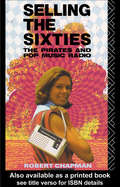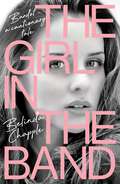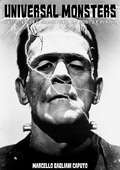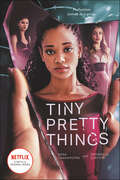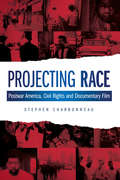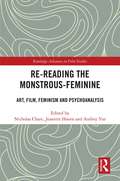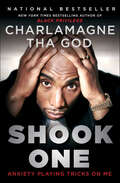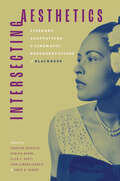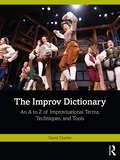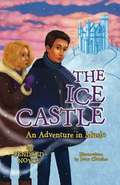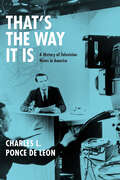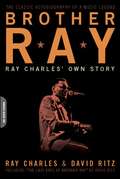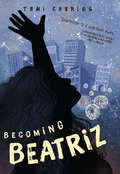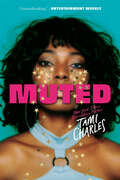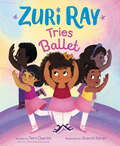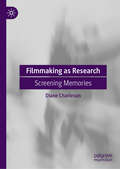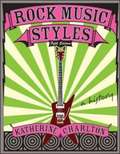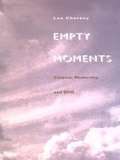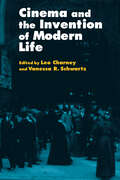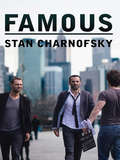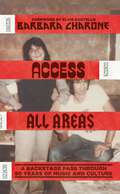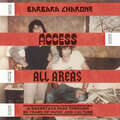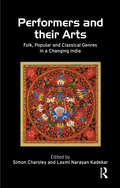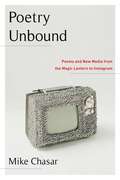- Table View
- List View
Selling the Sixties: The Pirates and Pop Music Radio
by Robert ChapmanWas it a non-stop psychedelic party or was there more to pirate radio in the sixties than hedonism and hip radicalism? From Kenny Everett's sacking to John Peel's legendary `Perfumed Garden' show, to the influence of the multi-national ad agencies, and the eventual assimilationof aspects of unofficial pop radio into Radio One, Selling the Sixties examines the boom of private broadcasting in Britain. Using two contrasting models of pop piracy, Radios Caroline and London, Robert Chapman sets pirate radio in its social and cultural context. In doing so he challenges the myths surrounding its maverick `Kings Road' image, separating populist consumerism from the economic and political machinations which were the flipside of the pirate phenomenon. Selling the Sixties includes previously unseen evidence from the pirates' archives, revealing interviews and an unrivalled selection of rare audio materials.
The Girl in the Band: Bardot – a cautionary tale
by Belinda ChappleThis is the story Bardot&’s Belinda Chapple has wanted to tell for twenty years – a cautionary tale of exploitation and heartbreak. In 2000, millions of Australians tuned in to watch Popstars, one of the world&’s first reality television competitions, in which five girls were selected from thousands to become members of a new band: Bardot. And Belinda Chapple signed a contract that would turn her life upside down. Bardot shot straight to fame and Belinda spent the following three years relentlessly rehearsing, recording and touring. The band released two very successful albums, a slew of hit singles, and performed on world stages to thousands of adoring fans. But Belinda discovered that the life of a popstar could be lonely, and it came with consequences she never saw coming. The impact on her body image was disastrous, and it was impossible to maintain romantic relationships, but at least she had her fellow band members to turn to for support … or so she thought.The Girl in the Band is a behind-the-curtains look at the ruthlessness of the entertainment industry. Belinda Chapple&’s story will resonate with anyone who&’s given up everything for a dream, only to have it shatter around them.
Universal Monsters L’Épopée des monstres en noir et blanc
by Héloïse Chapput Marcello Gagliani CaputoL'histoire des monstres qui ont donné vie au cinéma d'épouvante De la première adaptation du roman Le Fantôme de l'Opéra aux inoubliables Dracula de Tod Browning et Frankenstein de James Whale, Universal a écrit l'histoire mondiale du cinéma d'épouvante en immortalisant des personnages qui inspirent aujourd'hui encore de nombreux cinéastes. Complété d'une filmographie et préfacé par Nicola Lombardi (I ragni zingari, Madre Nera), l'essai représente un point de repère pour tous les curieux et passionnés de l'une des meilleures périodes du cinéma d'épouvante mondial.
Tiny Pretty Things (Tiny Pretty Things #1)
by Sona Charaipotra Dhonielle ClaytonNow a Netflix TV show! Black Swan meets Pretty Little Liars in this soapy, drama-packed novel featuring diverse characters who will do anything to be the prima at their elite ballet school.From the New York Times-bestselling author of The Belles, Dhonielle Clayton, and the author of the acclaimed Symptoms of a Heartbreak, Sona Charaipotra.Gigi, Bette, and June, three top students at an exclusive Manhattan ballet school, have seen their fair share of drama. Free-spirited new girl Gigi just wants to dance—but the very act might kill her. Privileged New Yorker Bette's desire to escape the shadow of her ballet-star sister brings out a dangerous edge in her. And perfectionist June needs to land a lead role this year or her controlling mother will put an end to her dancing dreams forever.When every dancer is both friend and foe, the girls will sacrifice, manipulate, and backstab to be the best of the best.Don’t miss the gossip, lies, and scandal that continues in Tiny Pretty Things’ gripping sequel, Shiny Broken Pieces!
Projecting Race: Postwar America, Civil Rights, and Documentary Film (Nonfictions)
by Stephen CharbonneauProjecting Race presents a history of educational documentary filmmaking in the postwar era in light of race relations and the fight for civil rights. Drawing on extensive archival research and textual analyses, the volume tracks the evolution of race-based, nontheatrical cinema from its neorealist roots to its incorporation of new documentary techniques intent on recording reality in real time. The films featured include classic documentaries, such as Sidney Meyers's The Quiet One (1948), and a range of familiar and less familiar state-sponsored educational documentaries from George Stoney (Palmour Street, 1950; All My Babies, 1953; and The Man in the Middle, 1966) and the Drew Associates (Another Way, 1967). Final chapters highlight community-development films jointly produced by the National Film Board of Canada and the Office of Economic Opportunity (The Farmersville Project, 1968; The Hartford Project, 1969) in rural and industrial settings. Featuring testimonies from farm workers, activists, and government officials, the films reflect communities in crisis, where organized and politically active racial minorities upended the status quo. Ultimately, this work traces the postwar contours of a liberal racial outlook as government agencies came to grips with profound and inescapable social change.
Re-reading the Monstrous-Feminine: Art, Film, Feminism and Psychoanalysis (Routledge Advances in Film Studies)
by Nicholas Chare Jeanette Hoorn Audrey YueThis book provides a critical reappraisal of Barbara Creed’s ground-breaking work of feminist psychoanalytic film scholarship, The Monstrous-Feminine, which was first published in 1993. The Monstrous-Feminine married psychoanalytic thinking with film analysis in radically new ways to provide an invaluable corrective to conventional approaches to the study of women in horror films, with their narrow emphasis on woman’s victimhood. This volume, which will mark 25 years since the publication of The Monstrous-Feminine, brings together essays by international scholars working across a variety of disciplines who take up Creed’s ideas in new ways and fresh contexts or, more broadly, explore possible futures for feminist and/or psychoanalytically informed art history and film theory.
Shook One: Anxiety Playing Tricks on Me
by Charlamagne Tha GodCharlamagne Tha God, New York Times bestselling author of Black Privilege and always provocative cohost of Power 105.1&’s The Breakfast Club, reveals his blueprint for breaking free from your fears and anxieties.Being &“shook&” is more than a rap lyric for Charlamagne, it&’s his mission to overcome. While it may seem like he&’s ahead of the game, he is actually plagued by anxieties, such as the fear of losing his roots, the fear of being a bad dad, and the fear of being a terrible husband. In the national bestseller Shook One, Charlamagne chronicles his journey to beat those fears and shows a path that you too can take to overcome the anxieties that may be holding you back. Ironically, Charlamagne&’s fear of failure—of falling into the life of stagnation or crime that caught up so many of his friends and family in his hometown of Moncks Corner—has been the fuel that has propelled him to success. However, even after achieving national prominence as a radio personality, Charlamagne still found himself paralyzed by anxiety and distrust. Here, in Shook One, he is working through these problems—many of which he traces back to cultural PTSD—with help from mentors, friends, and therapy. Being anxious doesn&’t serve the same purpose anymore. Through therapy, he&’s figuring out how to get over the irrational fears that won&’t take him anywhere positive. Charlamange hopes Shook One can be a call to action: Getting help is your right. His second book &“cements the radio personality&’s stance in making sure he&’s on the right side of history when it comes to society&’s growing focus on mental health, while helping remove the negative stigma&” (Billboard).
Intersecting Aesthetics: Literary Adaptations and Cinematic Representations of Blackness
by Charlene Regester, Cynthia Baron, Ellen C. Scott, Terri Simone Francis, and Robin G. VanderContributions by Cynthia Baron, Elizabeth Binggeli, Kimberly Nichele Brown, Priscilla Layne, Eric Pierson, Charlene Regester, Ellen C. Scott, Tanya L. Shields, and Judith E. Smith Intersecting Aesthetics: Literary Adaptations and Cinematic Representations of Blackness illuminates cultural and material trends that shaped Black film adaptations during the twentieth century. Contributors to this collection reveal how Black literary and filmic texts are sites of negotiation between dominant and resistant perspectives. Their work ultimately explores the effects racial perspectives have on film adaptations and how race-inflected cultural norms have influenced studio and independent film depictions. Several chapters analyze how self-censorship and industry censorship affect Black writing and the adaptations of Black stories in early to mid-twentieth-century America. Using archival material, contributors demonstrate the ways commercial obstacles have led Black writers and white-dominated studios to mask Black experiences. Other chapters document instances in which Black writers and directors navigate cultural norms and material realities to realize their visions in literary works, independent films, and studio productions. Through uncovering patterns in Black film adaptations, Intersecting Aesthetics reveals themes, aesthetic strategies, and cultural dynamics that rightfully belong to accounts of film adaptation. The volume considers travelogue and autobiography sources along with the fiction of Black authors H. G. de Lisser, Richard Wright, Ann Petry, Frank Yerby, and Walter Mosley. Contributors examine independent films The Love Wanga (1936) and The Devil’s Daughter (1939); Melvin Van Peebles's first feature, The Story of a Three Day Pass (1967); and the Senegalese film Karmen Geï (2001). They also explore studio-era films In This Our Life (1942), The Foxes of Harrow (1947), Lydia Bailey (1952), The Golden Hawk (1952), and The Saracen Blade (1954) and post-studio films The Learning Tree (1969), Shaft (1971), Lady Sings the Blues (1972), and Devil in a Blue Dress (1995).
The Improv Dictionary: An A to Z of Improvisational Terms, Techniques, and Tools
by David CharlesThe Improv Dictionary: An A to Z of Improvisational Terms, Techniques, and Tools explores improvisational approaches and concepts drawn from a multitude of movements and schools of thought to enhance spontaneous and collaborative creativity.This accessible resource reveals and interrogates the inherited wisdoms contained in the very words we use to describe modern improv. Each detailed definition goes beyond the obvious clichés and seeks a nuanced and inclusive understanding of how art of the moment can be much more than easy laughs and cheap gags (even when it is being delightfully irreverent and wildly funny). This encyclopedic work pulls from a wide array of practitioners and practices, finding tensions and commonalities from styles as diverse as Theatresports, Comedysportz, the Harold, narrative long-form, Playback Theatre, and Boal’s Theatre of the Oppressed. Entries include nuanced definitions, helpful examples, detailed explorations of the concepts in practice, and framing quotes from a leading practitioner or inspirational artistic voice.The Improv Dictionary offers valuable insights to novice improvisers taking their first steps in the craft, seasoned performers seeking to unlock the next level of abandon, instructors craving a new comprehensive resource, and scholars working in one of the numerous allied fields that find enrichment through collaborative and guided play.Each significant entry in the book is also keyed to an accompanying improv game or exercise housed at www.improvdr.com, enabling readers to dig deeper into their process.
The Ice Castle
by Joan Charles Pendred NoyceThe return to Lexicon begins when thirteen-year-old cousins Ivan and Daphne find their Aunt Adelaide deathly ill. Leaving their aunt to rest, Ivan and Daphne accidentally let their younger cousin, Lila, in on their secret world of Lexicon.Ivan and Daphne must track Lila, who disappears, through the frozen landscape to the Land of Winter where social status and freedom is determined by how well one sings. Fortunately for Lila, her musical talent lands her in the most favorable place. Separated by class now, the cousins face the cold, hunger, poverty, illness, injustice, and the malicious plotting of a power-hungry blind man. Slave, servant, and fine lady, the three cousins must escape their own imprisonment before they reunite, provoke a revolution, and restore spring to the Land of Winter.
That's the Way It Is: A History of Television News in America
by Charles L. Ponce de LeonWhen critics decry the current state of our public discourse, one reliably easy target is television news. It s too dumbed-down, they say; it s no longer news but entertainment, celebrity-obsessed and vapid. The critics may be right. But, as Charles L. Ponce de Leon explains in "That s the Way It Is," TV news has "always" walked a fine line between hard news and fluff. The familiar story of decline fails to acknowledge real changes in the media and Americans news-consuming habits, while also harking back to a golden age that, on closer examination, is revealed to be not so golden after all. Ponce de Leon traces the entire history of televised news, from the household names of the late 1940s and early 50s, like Eric Sevareid, Edward R. Murrow, and Walter Cronkite, through the rise of cable, the political power of Fox News, and the satirical punch of Colbert and Stewart. He shows us an industry forever in transition, where newsmagazines and celebrity profiles vie with political news and serious investigations. The need for ratings success and the lighter, human interest stories that can help bring it Ponce de Leon makes clear, has always sat uneasily alongside a real desire to report hard news. Highlighting the contradictions and paradoxes at the heart of TV news, and telling a story rich in familiar figures and fascinating anecdotes, "That s the Way It Is" will be the definitive account of how television has showed us our history as it happens. "
Brother Ray: Ray Charles' Own Story
by Ray Charles David Ritz<P>Ray Charles (1930-2004) led one of the most extraordinary lives of any popular musician. In Brother Ray, he tells his story in an inimitable and unsparing voice, from the chronicle of his musical development to his heroin addiction to his tangled romantic life. <P>Overcoming poverty, blindness, the loss of his parents, and the pervasive racism of the era, Ray Charles was acclaimed worldwide as a genius by the age of thirty-two. By combining the influences of gospel, jazz, blues, and country music, he invented, almost single-handedly, what became known as soul. And throughout a career spanning more than a half century, Ray Charles remained in complete control of his life and his music, allowing nobody to tell him what he could and couldn't do. <P>As the Chicago Sun-Times put it,Brother Ray is "candid, explicit, sometimes embarrassing, often hilarious, always warm, touching and deeply human-just like his music. "
Becoming Beatriz
by Tami CharlesBeatriz dreams of a life spent dancing--until tragedy on the day of her quinceañera changes everything.Up until her fifteenth birthday, the most important thing in the world to Beatriz Mendez was her dream of becoming a professional dancer and getting herself and her family far from the gang life that defined their days--that and meeting her dance idol Debbie Allen on the set of her favorite TV show, Fame. But after the latest battle in a constant turf war leaves her brother, Junito, dead and her mother grieving, Beatriz has a new set of priorities. How is she supposed to feel the rhythm when her brother's gang needs running, when her mami can't brush her own teeth, and when the last thing she can remember of her old self is dancing with her brother, followed by running and gunshots? When the class brainiac reminds Beatriz of her love of the dance floor, her banished dreams sneak back in. Now the only question is: will the gang let her go? Set in New Jersey in 1984, Beatriz's story is a timeless one of a teenager's navigation of romance, her brother's choices, and her own family's difficult past. A companion novel to the much-lauded Like Vanessa.
Muted
by Tami CharlesA ripped-from-the-headlines novel of ambition, music, and innocence lost, perfect for fans of Elizabeth Acevedo and Jason Reynolds!Be bold. Get seen. Be Heard.For seventeen-year-old Denver, music is everything. Writing, performing, and her ultimate goal: escaping her very small, very white hometown.So Denver is more than ready on the day she and her best friends Dali and Shak sing their way into the orbit of the biggest R&B star in the world, Sean "Mercury" Ellis. Merc gives them everything: parties, perks, wild nights -- plus hours and hours in the recording studio. Even the painful sacrifices and the lies the girls have to tell are all worth it.Until they're not.Denver begins to realize that she's trapped in Merc's world, struggling to hold on to her own voice. As the dream turns into a nightmare, she must make a choice: lose her big break, or get broken.Inspired by true events, Muted is a fearless exploration of the dark side of the music industry, the business of exploitation, how a girl's dreams can be used against her -- and what it takes to fight back.
Zuri Ray Tries Ballet
by Tami CharlesFrom New York Times bestselling author Tami Charles and rising star illustrator Sharon Sordo comes the first book in a charming picture book series about a fun, spunky girl with a huge heart! Meet Zuri Ray. She’s always willing to go the extra mile for family and friends and is up for any challenge. At least, that was before her best friend, Jessie, asked her to join a ballet camp. Now Zuri isn’t sure if she’s up for everything. While Jessie can’t wait to chassé and plié while wearing tight hair buns and frilly tutus, that doesn’t sound like Zuri at all! But she can’t let her friend down. Maybe classical ballet just needs a new spin . . . Perfect for fans of Fancy Nancy and Fresh Princess, Zuri Ray Tries Ballet encourages kids to follow their hearts and stay true to themselves!
Filmmaking as Research: Screening Memories
by Diane CharlesonThis book examines the challenges often experienced by film practitioners who find themselves researching within the academy, either as students or academics. In light of this the author presents her own journey from practitioner to researcher as a lens. Her practice- based research has been a quest to ”revision” memories, by creating filmic images that elicit memory and remembering. In so doing she has used a range of platforms: multi- screen video installation, still- framing the moving image and remixing found footage. Central to this research has been the importance of family storytelling and sharing, the relationship of the visual and memory, the agency of nostalgia and the role of aura, particularly evident in the re-appropriating of super 8 home movies into a variety of forms. Important to this is has been the relationship of the viewer and the viewed in particular the role of an immersive environment of viewing.
Rock Music Styles: A History, 5th Edition
by Katherine CharltonRock Music Styles blends musical commentary into an historical and social framework as it traces the development of rock music from its roots in country and blues to the most contemporary trends. Through well-chosen song examples and easy-to-read listening guides, students will experience firsthand the defining characteristics of rock styles and develop the ability to make connections between the popular music of yesterday and today.
Empty Moments: Cinema, Modernity, and Drift
by Leo CharneyIn Empty Moments, Leo Charney describes the defining quality of modernity as "drift"--the experience of being unable to locate a stable sense of the present. Through an exploration of artistic, philosophical, and scientific interrogations of the experience of time, Charney presents cinema as the emblem of modern culture's preoccupation with the reproduction of the present. Empty Moments creates a catalytic dialogue among those who, at the time of the invention of film, attempted to define the experience of the fleeting present. Interspersing philosophical discussions with stylistically innovative prose, Charney mingles Proust's conception of time/memory with Cubism's attempt to interpret time through perspective and Surrealism's exploration of subliminal representations of the present. Other topics include Husserl's insistence that the present can only be fantasy or fabrication and the focus on impossibility, imperfection, and loss in Kelvin's laws of thermodynamics. Ultimately, Charney's work hints at parallels among such examples, the advent and popularity of cinema, and early film theory. A book with a structural modernity of its own, Empty Moments will appeal to those interested in cinema and its history, as well as to other historians, philosophers, literary, and cultural scholars of modernity.
Cinema and the Invention of Modern Life
by Leo Charney Vanessa R. SchwartzCasting aside the traditional conception of film as an outgrowth of photography, theater, and the novel, the essays in this volume reassess the relationship between the emergence of film and the broader culture of modernity. Contributors, leading scholars in film and cultural studies, link the popularity of cinema in the late nineteenth century to emerging cultural phenomena such as window shopping, mail-order catalogs, and wax museums.
Famous
by Stan CharnofskyWealthy, mega-successful parents reared Harry Schiff to hunger for fame and fortune. At college he sees others throw off family fiats and successfully begin to define themselves. He meets Juliet, driven to be an actor, sensuous, passionate, yet never with commitment. His good friend, Katy Bloom, also a striving actor, becomes his confidante, secretly in love with him. A fourth buddy, Galen Thurston, an Adonis, blessed with Hollywood connections, gets a seeming break because of his father, but with strings. A tragedy explodes when Galen discovers his father’s ugly secret. The group’s chemistry is altered with an intrigue that involves both Harry’s and Galen’s parents. Juliet is on her rocket to fame, her own family’s tale so sordid that she cannot tolerate her father’s presence. Is Harry Juliet’s toy? She would deny it, but eventually, Harry must face off his two demons: his parents’ domination and Juliet’s emotional indifference. Resolution comes when he gets a heady break, screws up his courage to confront his issues, and sees Katy Bloom in another light. To be true to himself becomes more important than to become famous.
Access All Areas: A Backstage Pass Through 50 Years of Music And Culture
by Barbara CharoneFirst as a journalist and then a publicist at Warner Brothers Records for nearly twenty years, Barbara Charone has experienced, first-hand, the changes in the cultural landscape. Access All Areas is a personal, insightful and humorous memoir packed with stories of being on the cultural frontline, from first writing press releases on a typewriter driven by Tip Ex, then as a press officer for heavy metal bands taking the bus up to Donnington Festival with coffee, croissants and the much more popular sulfate. To taking on Madonna, an unknown girl from Detroit, and telling Smash Hits 'you don't have to run the piece if the single doesn't chart', and becoming a true pioneer in music, Charone continues to work with the biggest names in music, including Depeche Mode, Robert Plant, Foo Fighters and Mark Ronson at her agency MBCPR.The story of how a music-loving, budding journalist from a Chicago suburb became the defining music publicist of her generation, Access All Areas is a time capsule of the last fifty years, told through the lens of music.
Access All Areas: A Backstage Pass Through 50 Years of Music And Culture
by Barbara CharoneFirst as a journalist and then a publicist at Warner Brothers Records for nearly twenty years, Barbara Charone has experienced, first-hand, the changes in the cultural landscape. Access All Areas is a personal, insightful and humorous memoir packed with stories of being on the cultural frontline, from first writing press releases on a typewriter driven by Tip Ex, then as a press officer for heavy metal bands taking the bus up to Donnington Festival with coffee, croissants and the much more popular sulfate. To taking on Madonna, an unknown girl from Detroit, and telling Smash Hits 'you don't have to run the piece if the single doesn't chart', and becoming a true pioneer in music, Charone continues to work with the biggest names in music, including Depeche Mode, Robert Plant, Foo Fighters and Mark Ronson at her agency MBCPR.The story of how a music-loving, budding journalist from a Chicago suburb became the defining music publicist of her generation, Access All Areas is a time capsule of the last fifty years, told through the lens of music.
Access All Areas: A Backstage Pass Through 50 Years of Music And Culture
by Barbara CharoneFirst as a journalist and then a publicist at Warner Brothers Records for nearly twenty years, Barbara Charone has experienced, first-hand, the changes in the cultural landscape. Access All Areas is a personal, insightful and humorous memoir packed with stories of being on the cultural frontline, from first writing press releases on a typewriter driven by Tip Ex, then as a press officer for heavy metal bands taking the bus up to Donnington Festival with coffee, croissants and the much more popular sulfate. To taking on Madonna, an unknown girl from Detroit, and telling Smash Hits 'you don't have to run the piece if the single doesn't chart', and becoming a true pioneer in music, Charone continues to work with the biggest names in music, including Depeche Mode, Robert Plant, Foo Fighters and Mark Ronson at her agency MBCPR.The story of how a music-loving, budding journalist from a Chicago suburb became the defining music publicist of her generation, Access All Areas is a time capsule of the last fifty years, told through the lens of music.
Performers and Their Arts: Folk, Popular and Classical Genres in a Changing India
by Simon CharsleyIntroduction Part I: Caste, Community and performance A ritual performance of Kerala, Vayala Vasudevan PillaiThe Patuas of Bengal, Makbul IslamBards and goddesses: The Pombalas in Tirupati, Anand AkundyExplorations in the art forms of the Cindu madigas in Andhra, Y A Sudhakar Reddy and R R HarischandraCaste identity and performance in a fisher-village of Assam, Kishore BhattacharjeePart II: Performance Beyond CasteTelugu pady natakam in Andhra: Performance dynamics, P SubbacharyModernising tradition: The yaksagana in Karnataka, Guru Rao BapatKalarippayatt as aesthetics and the politics of invisibility in Kerala, P K SasidharanIndia People’s Theatre Association in colonial Andhra, V RamakrishnaGaddar and the politics and pain of singing, D Venkat RaoReviving moghal tamsa in Orissa, Sachi MohantyPart III: Classical Dance and its SuccessorsNew directions in Indian dance, Sunil KothariTranspositions in kuchipudi dance, Aruna BhikshuThe impact of commercialization in dance, K Subadra MurthyArt addressing social problems, Ananda Shankar Jayant
Poetry Unbound: Poems and New Media from the Magic Lantern to Instagram
by Mike ChasarIt’s become commonplace in contemporary culture for critics to proclaim the death of poetry. Poetry, they say, is no longer relevant to the modern world, mortally wounded by the emergence of new media technologies. In Poetry Unbound, Mike Chasar rebuts claims that poetry has become a marginal art form, exploring how it has played a vibrant and culturally significant role by adapting to and shaping new media technologies in complex, unexpected, and powerful ways.Beginning with the magic lantern and continuing through the dominance of the internet, Chasar follows poetry’s travels off the page into new media formats, including silent film, sound film, and television. Mass and nonprint media have not stolen poetry’s audience, he contends, but have instead given people even more ways to experience poetry. Examining the use of canonical as well as religious and popular verse forms in a variety of genres, Chasar also traces how poetry has helped negotiate and legitimize the cultural status of emergent media. Ranging from Citizen Kane to Leave It to Beaver to best-selling Instapoet Rupi Kaur, this book reveals poetry’s ability to find new audiences and meanings in media forms with which it has often been thought to be incompatible. Illuminating poetry’s surprising multimedia history, Poetry Unbound offers a new paradigm for understanding poetry’s still evolving place in American culture.
